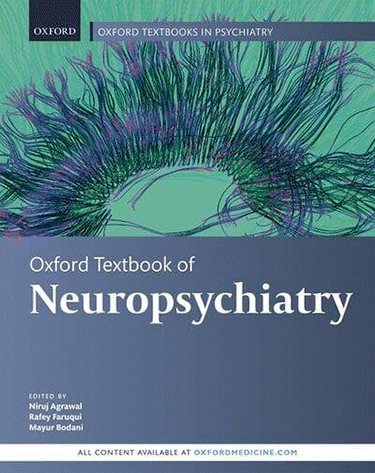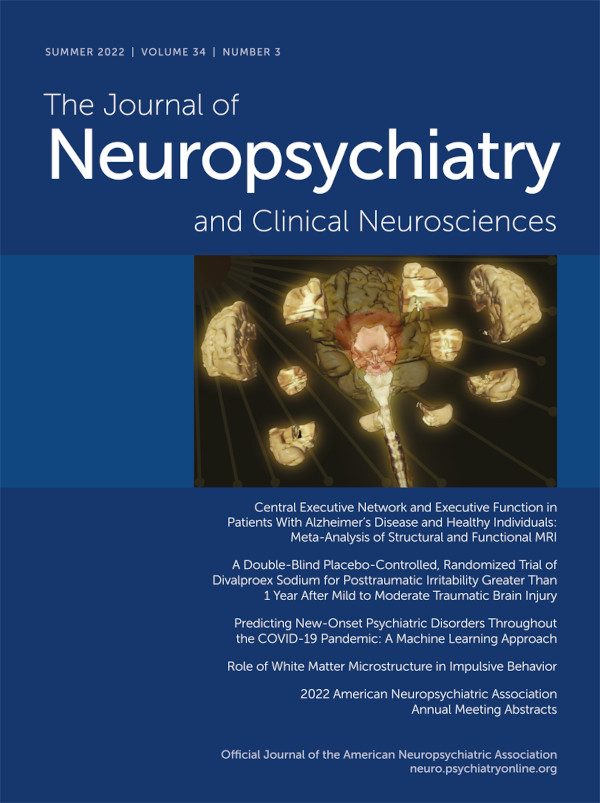Oxford Textbook of Neuropsychiatry

Edited by Niruj Agrawal, Rafey Faruqui, and Mayur Bodani, Oxford, United Kingdom, Oxford University Press, 2020, 608 pp., $165.00.
The Oxford Textbook of Neuropsychiatry, edited by Niruj Agrawal, Rafey Faruqui, and Mayur Bodani and published by Oxford University Press, is an ambitious advancement in the consolidation and dissemination of neuropsychiatric knowledge. Although this textbook is not the first or only entry in the field, it aims to differentiate itself from previous textbooks by being more current and concise, with an increased focus on global neuropsychiatry. It largely succeeds in these efforts, and I would recommend this textbook to others without reservation.
The text itself is organized into four sections—foundations and basic skills, core neuropsychiatric conditions, principles of treatment, and perspectives of neuropsychiatry worldwide—and it opens with an impassioned defense and definition of the discipline of neuropsychiatry. The editors’ stated mission is to develop a universal canon of neuropsychiatric knowledge that is designed specifically for trainees but will also be of use to specialists in the field, which is a near certainty because many of the invited authors are highly accomplished neuropsychiatrists.
In general, the text provides a solid overview of the neuropsychiatric field, beginning with its fascinating origins, and it includes basic principles of neuropsychiatric examination, diagnosis, and treatment. Numerous beautifully illustrated figures and the inclusion of relevant neuroimaging complement the content, which ranges from the fundamentals of neuroanatomy to the philosophical underpinnings of the field. Each chapter is almost without exception artfully and skillfully composed, and they certainly stand up well when read individually.
As a cognitive-behavioral neurologist, I found the chapters devoted to neuroanatomy, neurophysiology, structural and functional neuroimaging, and neurological examination to be at least as detailed and accurate as any I had throughout my own training, and the sections focused on neuropsychiatric aspects of individual diseases were often illuminating. The initial section on basic principles is a must-read for trainees from other disciplines who are interested in neuropsychiatry, although it might benefit from slight reorganization for the sake of continuity.
In the discussion of individual neuropsychiatric conditions, the case studies were very helpful to consolidate the information, although they were inconsistently used. Also, given that the stated purpose of the book is as a textbook, I was mildly disappointed by the uneven inclusion of important subsections such as background, neurobiology, clinical presentation, assessment, and so forth, which would help the reader build a consistent canon of knowledge between chapters. As it stands, this section reads as a series of beautiful and self-contained arias, whereas the choral component is only rarely appreciated, a small shortcoming that could perhaps be addressed in future editions.
The principles of treatment section was limited when compared with the descriptions of core conditions, which is perhaps a reflection of the disparity between our understanding of these diseases and currently available clinical treatment options, although the text comprehensively and competently covered psychopharmacology, cognitive-behavioral therapy, rehabilitation, and neurostimulation.
The final section on global perspectives is, in a single word, excellent. This work makes strides in expanding the historically narrow view of modern neuropsychiatry to include the non-Western world, often missing from other textbooks, and I read each section detailing my international colleagues’ efforts with interest and fascination. Unfortunately, the view allowed through this lens is still spotty, and voices from many parts of the world remain unheard.
Overall, I applaud the editors’ efforts to define and broaden the scope and range of the canon of neuropsychiatry. This textbook is an exhaustive compilation of information that will interest and enlighten trainees and experts alike, and the occasional discordant note is easily overlooked given the superb symphony from a new orchestra.



